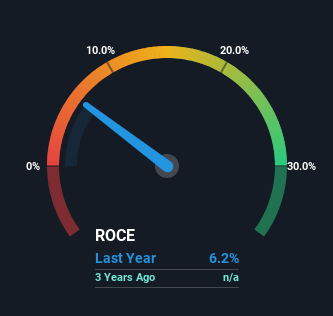- South Korea
- /
- Entertainment
- /
- KOSE:A352820
Here's What To Make Of HYBE's (KRX:352820) Decelerating Rates Of Return

If you're looking for a multi-bagger, there's a few things to keep an eye out for. Typically, we'll want to notice a trend of growing return on capital employed (ROCE) and alongside that, an expanding base of capital employed. Ultimately, this demonstrates that it's a business that is reinvesting profits at increasing rates of return. In light of that, when we looked at HYBE (KRX:352820) and its ROCE trend, we weren't exactly thrilled.
Understanding Return On Capital Employed (ROCE)
Just to clarify if you're unsure, ROCE is a metric for evaluating how much pre-tax income (in percentage terms) a company earns on the capital invested in its business. To calculate this metric for HYBE, this is the formula:
Return on Capital Employed = Earnings Before Interest and Tax (EBIT) ÷ (Total Assets - Current Liabilities)
0.062 = ₩258b ÷ (₩5.5t - ₩1.3t) (Based on the trailing twelve months to September 2023).
So, HYBE has an ROCE of 6.2%. On its own, that's a low figure but it's around the 6.9% average generated by the Entertainment industry.
Check out our latest analysis for HYBE

In the above chart we have measured HYBE's prior ROCE against its prior performance, but the future is arguably more important. If you'd like to see what analysts are forecasting going forward, you should check out our free analyst report for HYBE .
So How Is HYBE's ROCE Trending?
In terms of HYBE's historical ROCE trend, it doesn't exactly demand attention. The company has consistently earned 6.2% for the last two years, and the capital employed within the business has risen 43% in that time. Given the company has increased the amount of capital employed, it appears the investments that have been made simply don't provide a high return on capital.
The Key Takeaway
In conclusion, HYBE has been investing more capital into the business, but returns on that capital haven't increased. Since the stock has declined 13% over the last three years, investors may not be too optimistic on this trend improving either. All in all, the inherent trends aren't typical of multi-baggers, so if that's what you're after, we think you might have more luck elsewhere.
If you'd like to know about the risks facing HYBE, we've discovered 2 warning signs that you should be aware of.
For those who like to invest in solid companies, check out this free list of companies with solid balance sheets and high returns on equity.
Valuation is complex, but we're here to simplify it.
Discover if HYBE might be undervalued or overvalued with our detailed analysis, featuring fair value estimates, potential risks, dividends, insider trades, and its financial condition.
Access Free AnalysisHave feedback on this article? Concerned about the content? Get in touch with us directly. Alternatively, email editorial-team (at) simplywallst.com.
This article by Simply Wall St is general in nature. We provide commentary based on historical data and analyst forecasts only using an unbiased methodology and our articles are not intended to be financial advice. It does not constitute a recommendation to buy or sell any stock, and does not take account of your objectives, or your financial situation. We aim to bring you long-term focused analysis driven by fundamental data. Note that our analysis may not factor in the latest price-sensitive company announcements or qualitative material. Simply Wall St has no position in any stocks mentioned.
About KOSE:A352820
HYBE
Engages in the music production, publishing, and artist development and management businesses.
Excellent balance sheet with reasonable growth potential.

